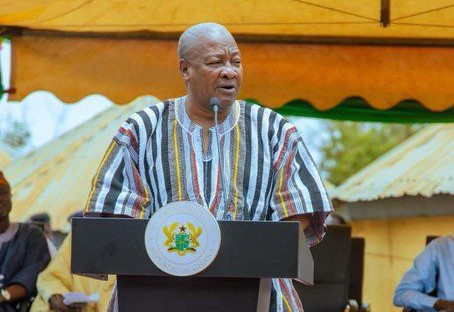President John Mahama has reaffirmed his commitment to building a new airport in the Upper East Region, a campaign promise he made before the 2024 general elections.
During his recent “Thank You Tour,” he revealed that he had directed the Ghana Airports Company Limited (GACL) to explore funding options for the project under a Public-Private Partnership (PPP) model, citing potential collaboration with gold mining companies.
“I have also asked the managing director of the Ghana Airport Company to commence the sourcing of funding for the construction of the Upper East Regional Airport. We intend to do this under a PPP module in conjunction with the gold mining companies in the region since this would also airlift their gold bulling safely to Accra from the Upper East Region,” he stated.
However, the critical question remains: Is the project economically viable?
Domestic Traffic Data
By the third quarter of 2024, Ghana’s domestic air passenger volume reached 623,704. Over the years, domestic air travel has seen fluctuations, with a peak of 852,101 passengers in 2022 before declining to 775,662 in 2023, reflecting slower growth. On average, annual domestic air traffic falls between 600,000 and 850,000, influenced by economic conditions and travel demand, according to data from the GACL.
In 2023, Tamale Airport accounted for approximately 25% of all domestic air travel in Ghana, handling 195,144 passengers. It has the capacity to handle approximately 400,000 passengers.
Conversely, Wa Airport recorded significantly lower traffic, with just 2,467 passengers in 2023, according to the Ghana Civil Aviation Authority. With its current terminal capacity of 150 passengers per hour, can accommodate about 50,000 passengers annually.
These two airports are about five or two hours away from Upper East Region respectively.
Auditor General’s 2024 Report
A review of the 2024 Auditor General’s Report on Ghana’s regional airports paints a concerning picture. In 2022, the five existing regional airports—Prempeh I International (Kumasi), Tamale, Sunyani, Wa, and Ho—collectively generated only GHS13.13 million, yet their operational costs ballooned to GHS39.14 million.
Notably, the Ho Airport in the Volta Region did not generate any revenue at all in 2022, despite accumulating operational costs of GHS1.38 million. This underutilisation of the airport has prompted the Mahama-led government to propose making the airport a Pilot Training School.
Similarly, Sunyani and Wa airports struggled to attract passengers, with revenues far below expenditures. Even the more established Kumasi and Tamale airports operated at a loss due to lack of passenger traffic.
The Report explicitly states that none of Ghana’s regional airports is economically viable. GACL’s management admitted that these airports are not revenue-generating and rely heavily on retained earnings or government support to remain operational.
“These regional airports are not revenue generating and cannot fund the required development projects which are needed to keep them operational. It must be emphasised that the creation of these non-commercially viable regional airports is a national policy. Airport infrastructure is highly capital intensive and can only be done through retained earnings,” GACL responded to the Auditor General.
Ghana’s domestic airline industry remains small, with only a few operators serving limited routes. If airports in Kumasi and Tamale, which serve larger populations, are struggling financially, a new airport in the Upper East Region may face similar underutilization, especially with the already existing Tamale and Wa airports.
Idle God Airport: Misplaced Priorities?
Rather than spending millions of dollars on another airport that risks becoming idle, the funds could be redirected to urgent regional needs. Many schools in the region still operate under trees or in deplorable conditions—money allocated for the airport could instead build proper classrooms and improve education infrastructure.
JoyNews’ “Crumbling Start” exposes the crisis in basic education across the five regions of northern Ghana. The PPP as a source of funding for the new Upper East Airport can be used to elevate basic schools in the region.
For instance, the $25 million spent on Ho Airport, which now sits largely unused, could have transformed local schools or provided clean water for communities in need.
Moreover, investing in better road and rail networks would offer a more sustainable transportation solution for the Upper East Region. Improved infrastructure would serve a larger population and enhance trade at a lower cost than air travel.
Latest Stories
-
Mahama warns leaders against ‘decisions that kill’ after debt crisis claims lives
39 seconds -
Wisconsin Attorney General sues to block Elon Musk $2m election giveaway
7 minutes -
Disney faces US investigation over DEI practices
12 minutes -
Hair relaxers linked to increased breast cancer risk in Ghanaian women
21 minutes -
Columbia University president resigns amid Trump crackdown
22 minutes -
CJ removal petition: Citizens must not sit back and watch politicians to get their way – NPP MP
29 minutes -
Thousands gather to bid farewell to ageless Ga music icon Naa Amanua Dodoo
47 minutes -
From despair to hope: Khadijah Bawuma receives life-changing scholarship after Myjoyonline report
1 hour -
Mob kills seven suspected kidnappers in Nigeria’s Edo state
2 hours -
Joseph Paintsil to make injury comeback after six weeks out
2 hours -
14 arrested over missing ECG containers at port
2 hours -
Energy Minister demands forensic audit over missing ECG containers
2 hours -
Joseph Paintsil unveils debut EP ‘Emergency’, set for April 4
3 hours -
Petition to remove CJ is not politically motivated – Adawuda
3 hours -
‘All that glitters is not gold’ – initial comments on Ghana’s Gold Board
3 hours

